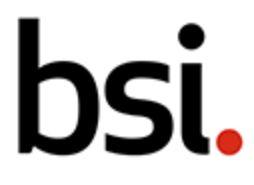Please be advised that a New Work Item Proposal has been loaded to the BSI Standards Development Portal for comment. We hope this will assist in increasing awareness of the Standards Development Portfolio.
Any comments received will be submitted to AMT/008 Additive manufacturing, for consideration when deciding the UK response to the associated Standards Development Organisation.
1st
Proposal: ISO/ASTM NP 52953 – Adoption as an EN ISO ASTM – Draft decision 78/2022 Additive Manufacturing for metals — General Principles — Registration of geometric data acquired from process-monitoring and for quality control.
Please visit http://standardsdevelopment.bsigroup.com/projects/9022-07049
Comment period end date: 09/05/2022
Scope
This document sets and defines the minimum requirements for registration of geometric data acquired from process-monitoring and for quality control in Additive Manufacturing (AM), including the description of a procedure.
Furthermore, this document comprises actions that users need to register multi-modal AM data and store them in an appropriate repository.
This document is not applicable for the following types of data: data cleansing, image processing, cost, production time and personnel.
This document in only applicable for geometric data gathered and generated from nondestructive test methods and sensors by using X-ray Computer Tomography (XCT), cameras and Coordinate Measuring Machines (CMM). This document is only applicable to metals produced through means of Laser-based powder bed fusion (PBF-LB) and Direct Energy Deposition (DED).
Note: The procedure can be applied to monitor other AM processes and materials (e.g. polymer or ceramic power bed fusion, binder jetting, and photopolymerization), but this document does not provide any data or case studies for them.
Purpose
Additive manufacturing (AM) is the general term for those technologies that successively join material to create physical objects as specified by 3D design model data.
The AM technologies are presently used for various applications in manufacturing industries for fabricating part with complex geometries that are not possible using the traditional manufacturing technologies, such as machining and welding.
Increasingly, Laser-based Powder Bed Fusion of Metals (PBF-LB/M) Additive Manufacturing (AM) fabrication machines are being instrumented with various types of nondestructive sensors. Typically, each sensor is designed to collect only one type of measurement dataset and in a unique coordinate system. Consequently, effectively monitoring PBF-LB/M fabrication processes and qualifying the resulting AM metal parts require the use of all the sensor datasets simultaneously. This, in turn, requires multi-modal dataset registration, which includes data alignment. Registration is needed to extract and characterize process signatures, which are needed to control variations in powder spreading, melt-pool geometry, thermal stability, layer integrity, and part quality.
Registration of these datasets covers meta data, data cleaning, data correction (due to distortion), data identification, and data alignment. During the fabrication of parts using additive manufacturing technology, there have been numerous different sensors and inspection instruments in use for in-situ monitoring and ex-situ inspection, often with reference to specific data types and in their own, local coordinate systems. This is often ambiguous and confusing, which hampers part validation and process qualification.
It is the intention of this document to provide a procedure and methods to register geometric data acquired from process-monitoring and for quality control in Additive Manufacturing (AM), including the description of a procedure. Those includes 1) accessing validated data with known time, locations, and approvals, 2) data alignment and fusion for process monitoring and control, 3) detecting defects traceable to process, material, equipment parameters, 4) AM part qualification, and 5) understanding AM process for developing predictive models.
The objective of this standard is the geometric data registration for metals through means of nondestructive sensors by using X-ray Computer Tomography (XCT), cameras and Coordinate Measuring Machines (CMM) to increase cost savings in data management, curation, and access.
2nd
Proposal: ISO/ASTM NP 52919 Adoption as an EN ISO ASTM – Draft decision 79/2022 – Test method for sand molds for metal casting.
Please visit http://standardsdevelopment.bsigroup.com/projects/9022-07041
Comment period end date: 11/06/2022
Scope
This document defines test methods for sand molds for metal casting produced by means of additive manufacturing technologies. The test methods include the determination of mechanical and physical properties such as, but not limited to, tensile strength, transverse strength, gas permeability, and also others.
Purpose
There is no international standard for testing AM made sand molds for metal casting, although some standardized test methods for conventionally made sand molds have been locally used in AFS (American Foundry Society) in United States of America, JACT(Japanese Association of Casting Technology) in Japan, VDG (German Foundrymen’s Association) in Germany and so on. As the developments of AM technology, international trade and industry relating to metal casting utilizing AM technology are expected to spread, demand for an international standard has been growing. In addition, AM made sand molds require the specific test methods which differ from it for conventional sand molds in accordance with AM specific factors causing unevenness of properties, for example bending strength and gas permeability evaluation. The result of this project enables to provide appropriate means evaluating mold property to be shared by international stakeholders such as AM machine supplier, castings foundry and casting products user
If you have any comment or need more information, please contact Sami Ortiz at [email protected]

